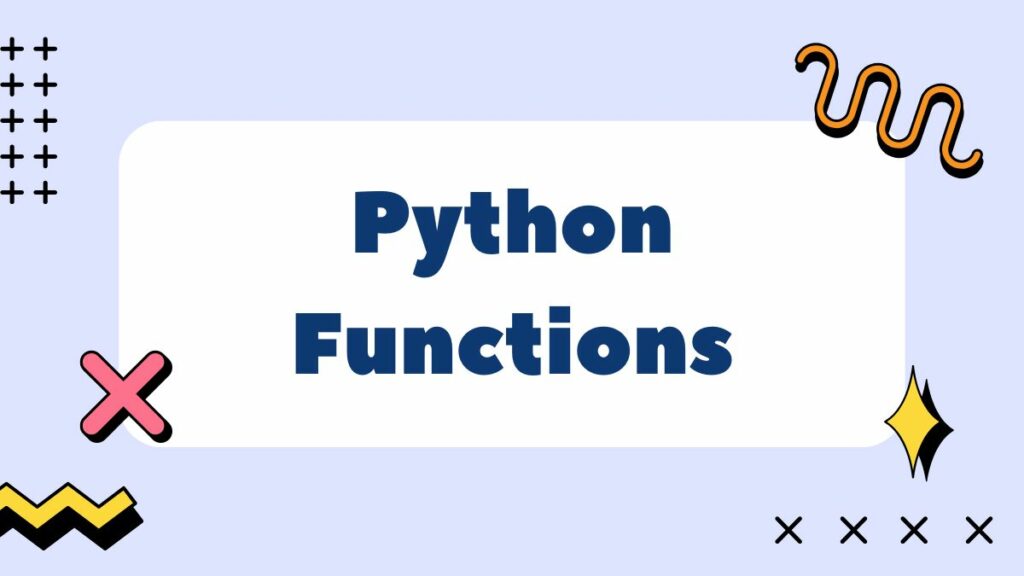Functions are fundamental building blocks in Python programming. A Python function allows us to encapsulate reusable code and improve code organisation and readability.
Let us learn how we can use functions effectively in Python.
Understanding Functions
A function is a block of code that performs a specific task. It takes input parameters, processes the data, and returns an output value (if applicable). By defining functions, we can break down complex problems into smaller, more manageable components, making our code easier to understand, maintain, and reuse.
Creating Functions
To create a Python function, the keyword def is used along with the name of the function, parentheses for parameters, and a colon. The function body is indented below the colon.
| def greet(name):
print("Hello, " + name + "!") greet("Sritama") |
Parameters and Arguments
- Parameters: Variables defined within the function parentheses that receive values when the function is called.
- Arguments: The actual values passed to the function when it is called.
We can define functions with multiple parameters.
Example:
| def add(x, y):
return x + y result = add(3, 4) print(result) # Output: 7 |
Python Function Examples
Return Values
Functions can return values using the return statement. If a function doesn't have a return statement, it implicitly returns None.
Example:
| def square(x):
return x * x result = square(5) print(result) # Output: 25 |
Function Scope
Variables defined within a function have local scope, meaning they are only accessible within the function. Variables defined outside of functions have a global scope, meaning they can be accessed from anywhere in the program.
Example:
| global_var = 10
def my_function(): local_var = 5 print(global_var) # Accessing global variable print(local_var) # Accessing local variable my_function() |
Default Parameters
You can assign default values to function parameters. If no argument is provided for a parameter, its default value is used.
Example:
| def greet(name, greeting="Hello"):
print(greeting + ", " + name + "!") greet("Sritama") # Output: Hello, Sritama! greet("Arunima", "Hi") # Output: Hi, Arunima! |
Keyword Arguments
You can pass arguments to functions by keyword, specifying the parameter name followed by the value. This allows you to pass arguments in any order.
Example:
| def greet(name, greeting="Hello"):
print(greeting + ", " + name + "!") greet(greeting="Hi", name="Alice") # Output: Hi, Alice! |
Variable-Length Arguments
We can use the *args syntax to pass a variable number of positional arguments to a function. The *args parameter collects all positional arguments into a tuple.
Example:
| def add_numbers(*args):
sum = 0 for num in args: sum += num return sum result = add_numbers(1, 2, 3, 4) print(result) # Output: 10 |
Docstrings
Docstrings are string literals that provide documentation for functions. They are placed as the first statement within a function and can be accessed using the __doc__ attribute.
Example:
| def greet(name):
"""Greets the user with a personalised message.""" print("Hello, " + name + "!") print(greet.__doc__) # Output: Greets the user with a personalised message. |
Recursive Functions
Recursive functions call themselves directly or indirectly. They are often used to solve problems that can be broken down into smaller, similar subproblems.
Example:
| def factorial(n):
if n == 0: return 1 else: return n * factorial(n - 1) result = factorial(5) print(result) # Output: 120 |
Lambda Functions
Lambda functions are anonymous functions defined using the lambda keyword. They are often used as arguments for other functions.
Example:
| my_lambda = lambda x: x**2
result = my_lambda(5) print(result) # Output: 25 |
Best Practices for Writing Functions
- Use Clear and Descriptive Names: Choose function names that accurately reflect their purpose.
- Keep Functions Small and Focused: Avoid writing overly long or complex functions. Break down large functions into smaller, more manageable ones.
- Document Your Functions: Use docstrings to provide clear explanations of what your functions do and how to use them.
- Test Your Functions: Write unit tests to ensure that your functions work as expected and catch errors early in the development process.
- Avoid Global Variables: Minimise the use of global variables to improve code maintainability and avoid unintended side effects.
- Consider Using Functional Programming Techniques: Explore functional programming concepts like lambda functions, map, filter, and reduce to write concise and expressive code.
- Leverage Built-in Functions: Python provides many built-in functions that can simplify common tasks, such as map, filter, reduce, sorted, and zip.
- Parameter Validation: Consider adding input validation to ensure that functions are called with valid arguments.
- Avoid Side Effects: Functions should ideally have no side effects, meaning they should only return values and not modify the global state.
Advanced Concepts for Functions in Python
Decorators: Decorators are functions that modify the behaviour of other functions. They can be used for tasks like logging, caching, or timing.
Generators: Generators are functions that return an iterator, allowing you to generate values on the fly and avoid creating large lists in memory.
Closures: Closures are functions that capture variables from their enclosing scope and can be used to create private or persistent data.
Higher-Order Functions: Higher-order functions are functions that take other functions as arguments or return functions. They are essential for functional programming paradigms.
Wrapping Up
By mastering functions, you can write more organised, efficient, and maintainable Python code. A Python function allows us to break down complex problems into smaller, reusable components, improve code readability, and enhance code reusability. By following the best practices and tips outlined in this guide, you can effectively use functions in Python to create powerful and efficient Python applications.
If you wish to become a master in Python programming, sign up for the Postgraduate Program In Data Science And Analytics by Imarticus Learning. This holistic data science course will teach you all the skills and technologies you will need for a solid career in data science.
Frequently Asked Questions
How to write functions in Python?
To write a Python function, the keyword def is used along with the name of the function and parentheses containing the parameters. The function body is indented below the colon. Optionally, we can use the return statement to specify a value to be returned.
What is the purpose of docstrings in Python functions?
Docstrings provide documentation for functions, explaining their purpose, parameters, return values, and usage.
How can you pass a variable number of arguments to a function in Python?
You can use the *args syntax to pass a variable number of positional arguments to a function.
What is a lambda function?
A lambda function is a small, anonymous function defined using the lambda keyword. They are often used as arguments for other functions.
What is the difference between a local variable and a global variable?
A local variable is defined within a function and is only accessible within that function. A global variable is defined outside of any function and can be accessed from anywhere in the program.
What is the purpose of the return statement in a function?
The return statement is used to specify the value that a function will return to the caller. If a function doesn't have a return statement, it implicitly returns None.









